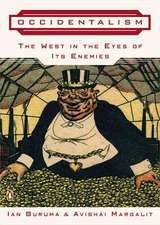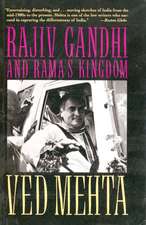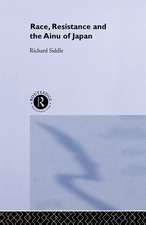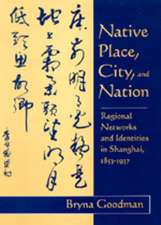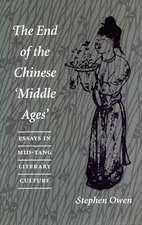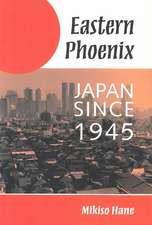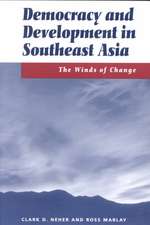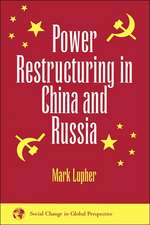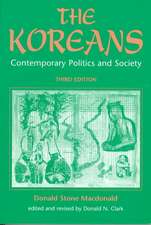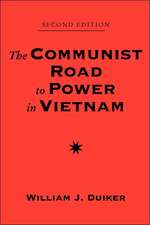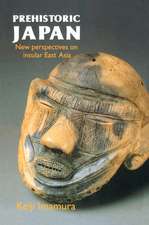Inventing Japan: 1853-1964: Modern Library Chronicles
Autor Ian Burumaen Limba Engleză Paperback – 31 oct 2004
What explains the seismic changes that thrust this small island nation so violently onto the world stage? In part, Ian Buruma argues, the story is one of a newly united nation that felt it must play catch-up to the established Western powers, just as Germany and Italy did, a process that involved, in addition to outward colonial expansion, internal cultural consolidation and the manufacturing of a shared heritage. But Japan has always been both particularly open to the importation of good ideas and particularly prickly about keeping their influence quarantined, a bipolar disorder that would have dramatic consequences and that continues to this day. If one book is to be read in order to understand why the Japanese seem so impossibly strange to many Americans, Inventing Japan is surely it.
From the Hardcover edition.
Din seria Modern Library Chronicles
-
 Preț: 125.06 lei
Preț: 125.06 lei -
 Preț: 94.47 lei
Preț: 94.47 lei -
 Preț: 88.68 lei
Preț: 88.68 lei -
 Preț: 119.77 lei
Preț: 119.77 lei -
 Preț: 94.66 lei
Preț: 94.66 lei -
 Preț: 120.59 lei
Preț: 120.59 lei -
 Preț: 112.52 lei
Preț: 112.52 lei -
 Preț: 113.97 lei
Preț: 113.97 lei -
 Preț: 98.34 lei
Preț: 98.34 lei -
 Preț: 103.09 lei
Preț: 103.09 lei -
 Preț: 144.04 lei
Preț: 144.04 lei -
 Preț: 122.45 lei
Preț: 122.45 lei -
 Preț: 110.47 lei
Preț: 110.47 lei -
 Preț: 105.19 lei
Preț: 105.19 lei -
 Preț: 115.75 lei
Preț: 115.75 lei -
 Preț: 117.35 lei
Preț: 117.35 lei -
 Preț: 96.67 lei
Preț: 96.67 lei -
 Preț: 109.24 lei
Preț: 109.24 lei -
 Preț: 101.71 lei
Preț: 101.71 lei -
 Preț: 96.46 lei
Preț: 96.46 lei
Preț: 88.86 lei
Nou
Puncte Express: 133
Preț estimativ în valută:
17.00€ • 17.80$ • 14.15£
17.00€ • 17.80$ • 14.15£
Carte disponibilă
Livrare economică 10-24 martie
Preluare comenzi: 021 569.72.76
Specificații
ISBN-13: 9780812972863
ISBN-10: 0812972864
Pagini: 194
Dimensiuni: 132 x 203 x 15 mm
Greutate: 0.18 kg
Ediția:Mod Lib PB.
Editura: Modern Library
Seria Modern Library Chronicles
ISBN-10: 0812972864
Pagini: 194
Dimensiuni: 132 x 203 x 15 mm
Greutate: 0.18 kg
Ediția:Mod Lib PB.
Editura: Modern Library
Seria Modern Library Chronicles
Notă biografică
Ian Buruma studied and worked in Japan for many years. He is the author of Bad Elements, The Missionary and the Libertine, Anglomania, A Japanese Mirror, God’s Dust, The Wages of Guilt, and Playing the Game. He lives in London.
From the Hardcover edition.
From the Hardcover edition.
Extras
1
The Black Ships
When Commodore Matthew (“Old Matt”) Calbraith Perry sailed into Edo Bay on July 8, 1853, with four heavily armed ships, on a mission to open up Japanese ports to American ships, he could be forgiven for thinking the Japanese were an ignorant people. Japan had been cut off from most other countries for roughly two hundred years. Japanese rulers, fearful of foreign aggression and worried that Christianity, promoted by European missionaries, would make their subjects unruly, had outlawed the Christian religion, expelled most foreigners and all priests, and forbidden Japanese to go abroad. Anyone bold enough to defy these rules faced execution, usually of a most gruesome kind. Few were so bold. Trade with China and Korea still went on, but since the 1630s, the Western presence in Japan had been limited to a handful of bored Dutch merchants confined to a tiny man-made island off the city of Nagasaki.
It was one of the most extraordinary confrontations in modern history. There was Perry with his four “black ships of evil,” thundering an ominous salute at the Japanese coast by firing his cannon. And there were the Japanese, lined up on the shore, armed with swords and old-fashioned muskets. Commodore Perry insisted on dealing only with the highest representatives of the Japanese government, without really knowing who they were. The distinction in his mind between the emperor, a grand but still powerless figure, and the shogun was fuzzy. The emperor, living in Kyoto, the old imperial capital, was the symbol of Japanese cultural continuity. His duties were ceremonial and spiritual, while the shogun ruled, as the samurai generalissimo, from his seat in Edo, today’s Tokyo. From 1603, the shoguns all belonged to the Tokugawa clan, hence the name of their government, Tokugawa bakufu (shogunate), also known as Edo bakufu.
Perry, however, unaware of all this, kept on insisting that his letter from President Millard Fillmore of the United States of America, demanding the right to put up and trade at Japanese ports, be taken straight to the emperor, who, even if such a letter had ever reached him, would not have known what to do with it.
Communications with the Japanese were laborious, since the only European language known to their interpreters was Dutch. After Portuguese missionaries were banned from Japan in the seventeenth century, Dutch merchants, who were more interested in money than spreading the faith, were the only Europeans allowed to stay. The Japanese officials, though curious about American armaments and content to drink brandy and sugar on board Perry’s flagship, were under instruction to tell the “flowery-flagged devils” to go away. They insisted that the only place to conduct business with foreigners was Nagasaki. But Perry, confident in the power of his guns, refused to budge. The Reverend Samuel Wells Williams, the official American interpreter, whose grasp of Japanese was tenuous, wrote in his journal that “the universal Yankee nation” had come “to disturb [Japan’s] apathy and long ignorance.”
When, after long deliberations, during which the Japanese countered Perry’s imperious behavior with polite vagueness and other stalling tactics, Perry was finally allowed to go ashore, the two sides set out to impress each other with as much pomp as they could muster. The commodore strode forth, flanked by his two tallest black bodyguards. The Japanese were dressed in their finest silks. Presents were exchanged: rich brocades, porcelain bowls, lacquer boxes, fans, and other finely worked treasures for the Americans; a telegraph and a miniature train for the Japanese. The Japanese brought on some sumo wrestlers, whose stomachs Perry was invited to punch. Many toasts were drunk, and one of the Japanese officials, after consuming large amounts of whiskey and champagne, threw his arms around the commodore and said, in the common fashion of Japanese men celebrating international friendship in a drunken state: “Nippon and America, all the same heart.”
Williams, a cool man of the cloth, noted that it was indeed “a curious mélange” of East and West, “railroads and telegraph, boxers and educated athlete . . . shaven pates and nightgowns, soldiers with muskets and drilling in close array, soldiers with petticoats, sandals, two swords, and all in disorder, like a crowd—all these things and many other things, exhibiting the difference between our civilization and usages and those of this secluded, pagan people.” The Japanese gifts were clearly those of a “partially enlightened people,” while the American presents showed “the success of science and enterprise” of “a higher civilization.”
Twenty years later, many Japanese would take the same view, as though the “universal” West had come to bring light to a nation sunk in medieval darkness.
Commodore Perry may indeed have been convinced that his was a mission of enlightenment of lesser breeds, but his more immediate concern, on this and on a second mission in 1854, was to further the interests of American trade. The sixty-one guns on the decks of his ships, and the woefully unprepared Japanese coastal defenses (most cannon were fake, and there was no Japanese navy), finally convinced the shogun’s government in Edo that compromise was preferable to a suicidal war. Henceforth, American ships were permitted to enter two designated Japanese ports and load up on coal and other supplies, for which they would pay as a first step toward establishing trade relations.
All this was hugely gratifying from an American point of view, and Commodore Perry would be remembered in history as the man who “opened” Japan, a distinction that Perry himself was the first to claim and widely trumpet during his lifetime. It is true that Perry’s black ships, as well as other Western vessels lurking in the neighborhood, provoked a political crisis in Japan that led to the end of self-imposed isolation. The vulnerability of the Edo bakufu, whose autocratic rule had lasted more than two centuries, was shown up by superior foreign force, rather in the way that Japanese armies exposed the fragility of European empires in World War II. The Japanese were deeply divided about the best way to respond. Some factions, in a minority, had argued for some time to let the foreigners in and open Japan to trade. Others were in favor of rejecting the barbarians at any cost. A growing number of disgruntled provincial samurai and intellectuals were plotting to bring down the discredited bakufu and place the emperor (and themselves) at the center of a more vigorous state. Militant hotheads on the other side sought to cut down any opposition to the shogun. Perry alone was not responsible for creating all this ferment, but his actions surely brought things to a head.
However, Perry’s assumption of Japanese ignorance could not have been further from the truth. At the time of his arrival in Edo Bay, the Japanese elite knew more about America than Americans knew about Japan. Indeed, despite their relative isolation, the Japanese knew more about the West than most other Asians did, including the Chinese. The extent of their knowledge of American and British politics, of Western science, medicine, history, and geography, was truly remarkable. They had detailed maps of the United States. They knew about U.S. political institutions. Western science had been introduced in the seventeenth century. Studies had been made of the Russian military, the British economy, and much more besides. More important, however, in light of things to come, were the conclusions Japanese drew from their studies.
It is often assumed that Christianity never had a chance in Japan. In fact, sixteenth-century Spanish and Portuguese missionaries were so successful in converting Japanese, especially among the elite, that the shoguns and their house intellectuals developed a deep fear of the Western faith. Japanese converts were massacred in 1638, foreign missionaries expelled, and all foreign books assumed to contain a Christian message banned, including scientific books by Matteo Ricci and, more oddly, Euclid’s Elements and Cicero’s On Friendship. But this didn’t bring Western learning to a halt. The banning of presumed Christian propaganda in the early seventeenth century, and the presence of the Dutch merchants in Nagasaki, led to the emergence of Rangaku, Dutch learning. The students of this new discipline were called Rangakusha, or Dutch scholars.
The popular image of the Dutch was that of exotic beasts, who lifted their legs, like dogs, when they relieved themselves. Their hair was red and their eyes a devilish blue. But the official translators in Nagasaki, who also acted as state security agents, rather like the official guides in communist countries a few centuries later, quickly noticed the effectiveness of Western medicine and by implication the inadequacies of Chinese methods. Without dictionaries or grammars, they learned to read Dutch, an extraordinary intellectual achievement, and a number of physicians in Nagasaki and Edo became diligent scholars of European medical science. There was some official interest in Dutch matters, too. Once a year Dutch merchants were summoned to Edo, where the shogun and his entourage would pump them with questions and, for their amusement, ask them to sing songs, dance, kiss one another, and generally perform like circus animals.
In 1720, the ban on Western books was relaxed by the shogun, Tokugawa Yoshimune, who took a more serious interest in European affairs. He had an unusually open mind, but he was also a traditional ruler who felt responsible, like Chinese emperors, for agricultural prosperity. It was a time of commercial growth in the cities and violent rural unrest. To prevent more peasant riots, Yoshimune sought to improve life on the land. Since time is an essential factor in agriculture, the shogun was concerned about the calendar. After being advised that Europeans had a more accurate way of measuring time than the Chinese, he decided to encourage Dutch learning. “People of the red-hair country,” he said, “customarily do things by mental reckoning and by reason; they only use implements they can see; if a fact is not certain, they do not say so, and they do not make use of it. . . .”
Although Yoshimune’s interest in Dutch learning was practical more than philosophical, his attitude was quite different from that of Chinese emperors, who conceived of their celestial empire as the center of the world. His successors were not always as curious and broad-minded, and Dutch learning remained a precarious business, especially in the early nineteenth century, when the government cracked down on heterodox teachings. No matter how patriotic and even conservative most Dutch scholars were, a faint suspicion of treachery hung over those who showed too keen an interest in foreign matters. The authorities—and most scholars, too—took the line that although Western science might be a useful tool to rule Japan more effectively, foreign thinking should be kept far from common minds, lest the people get “confused” and forget to obey their rulers.
The ideology of the Tokugawa bakufu was neo-Confucianism, a particularly conservative strand of Confucianism devised in the twelfth century by a Chinese philosopher named Chu Hsi, who stressed the importance of natural order and, in the Japanese interpretation, absolute obedience to authority. The role of official Confucian scholars was to define the dogma and make sure people adhered to it. They were like clerics, empowered to interpret the rules of heaven. The great liberal nineteenth-century educator Fukuzawa Yukichi described the limits of this tradition well: “In our country, learning has meant learning belonging to the world of the rulers; it has been no more than a branch of the government.” Many of these Confucianists, or jusha, were teachers and doctors of Chinese medicine. Western learning, which contradicted some of their most cherished beliefs, was a direct threat to their status, so it was in their interest to see its promoters cut down to size.
Getting too close to foreign teachers could have tragic consequences. One of the most scholarly members of the Dutch trade mission in Nagasaki was a dour physician of German origin named Philipp Franz von Siebold. A voracious collector of things Japanese, von Siebold had many devoted Japanese disciples. On a trip to Edo in 1826, he exchanged gifts with Takahashi Kageyasu, the distinguished interpreter and student of astronomy known to the Dutch as Globius. Von Siebold received a map of Japan, and Globius was given a naval map of the world. As soon as news of this exchange leaked out, von Siebold was arrested for spying and later expelled, while Globius died in prison three years later, possibly by his own hand.
Another unfortunate scholar was a young man named Yoshida Shoin, who was so desperate to learn more about the Western world that he begged Commodore Perry to take him back to America on his ship. Perry refused. Yoshida was arrested for embarking on this adventure and locked up in a cage. His teacher, Sakuma Shozan, who had developed theories, based on his Western knowledge, on the best ways to defend Japan against foreign incur- sions, was imprisoned for encouraging his pupil to study overseas. He wrote a famous treatise, entitled Reflection on My Errors. After his release, he was murdered by anti-Western fanatics for riding his horse on a European-style saddle.
Foreign learning, then, could be dangerous. But most Dutch scholars, even those who advocated a compromise solution to the foreign crisis provoked by Perry’s arrival, were hardly political rebels. Most were too careful, or too indifferent, to be involved in political affairs. Almost all were ardent patriots anyway, who believed in the neo-Confucian rules of obedience even as they criticized Sino-centric obscurantism. Globius, the same man who exchanged gifts with Philipp von Siebold and died as a suspected traitor, had advised his government in 1825 to drive away all foreign ships from the Japanese coast. It would be nice if one could divide Japanese thinkers of the eighteenth and nineteenth (or indeed twentieth) centuries into progressive, liberal, democratic Westernizers on the one side and reactionary, nativist authoritarians on the other. But that is not the way it was or is. The keenest promoters of trade and compromise—there were many Dutch scholars among them—still argued that one day, when Japan had learned enough from the barbarians to resist them, the country could safely be closed again.
Even if the students of Dutch science were not aware of it themselves, their knowledge helped to undermine the philosophical legitimacy of the Confucian state. The Japanese had borrowed a Chinese concept of statecraft based on cosmic principles: The natural order of human society followed the natural order of the cosmos, and a benevolent ruler had to make sure they remained in harmony. Confucian ethics were believed to be in line with the principles of nature. Dutch learning introduced an entirely different view of the world. If the principles of nature could be analyzed through reason, and the cosmology underpinning the Confucian state refuted by science, this would constitute a serious challenge to political legitimacy.
The impact of Western science in China was, if anything, more serious than in Japan, for it showed that China was not the center of the universe. The Chinese way to stave off the consequences of what might have been an ethical revolution was to separate Chinese ethics from Western science, as though European ideas had no ethical implications. A popular saying in the late nineteenth century was “Chinese learning for the essential principles, Western learning for the practical applications.” In fact, it never really worked in China. Western learning couldn’t be reduced to mere technology without gross distortion, and the old Sino-centric principles were hard to reconcile with scientific inquiry. This is why Chinese thinkers since the nineteenth century have tended to lurch from sullen conservatism to violent iconoclasm. Either the Chinese tradition, whatever it was supposed to be, had to be defended against the merest speck of foreign pollution or every vestige of it had to be smashed in the name of science. The history of communist China is an illustration of both.
The Japanese response to Western ideas was similar but less traumatic, or at least it was traumatic in a different way. Japanese intellectuals, too, used the face-saving formula “Western science, Japanese essence.” It never quite worked in Japan, either, but Japan had the great advantage of being in the cultural borderlands. Japanese thinkers could shift fairly easily from seeing China as the center of wisdom to finding another center of orientation. The point was that few Japanese had illusions about the world revolving around Japan. They may have thought Japan was uniquely favored as a divinely blessed land, but it was one land competing with many others. They also knew that their political system, and the principles upon which it was based, had been imported from China, and there was nothing to stop them from borrowing from somewhere else when the old order was no longer working.
Another important difference with China was the separation of powers. In China, both secular and political power were concentrated in the imperial court. In Tokugawa Japan, the shogun ran the country like a military strongman, while the emperor was more like a pope, whose blessing was used to legitimate the secular rulers. This arrangement was somewhat complicated by the fact that the shoguns, who belonged to a dynasty as much as the emperors, began to acquire imperial trappings of their own. But the separation of powers had one great advantage. It was possible to rebel against the government, especially if it was done in the name of loyalty to the emperor, without seeming to be unpatriotic. The same was not so easy in China.
Western influence has often been a catalyst for radical change in Japan, but it was by no means the only reason the bakufu system began to look threadbare. Already in the seventeenth century an increasingly wealthy and sophisticated merchant class had developed in coastal cities, especially Osaka. They traded in commodities, entered into free contracts, and speculated on futures markets. As the merchants, who were officially classified as a lower caste than peasants and artisans, got richer, the samurai, nominally at the top of the caste system, often became useless and, in the eighteenth and nineteenth centuries, progressively poorer. What was a professional warrior to do in times of peace? There were far too many samurai to give them all government jobs, and to engage in business was beneath their dignity. The romantic tracts, which became so popular in the West three hundred years later, about warrior codes and samurai chivalry were really a sign of idleness. The caste system, aimed at keeping the samurai on top and the merchants in their place, was out of step with economic developments. And the policy of national isolation cut Japan off from technological progress.
News of the disastrous Opium Wars in the 1840s came as a shock, for it not only proved how backward China had become, it showed Japan’s own vulnerability. In fact, however, many Japanese had suspected as much long before that. After barbarian Manchus had toppled the Ming dynasty in 1644, the Middle Kingdom began to lose much of its prestige. Around the time that the free-spirited shogun Tokugawa Yoshimune encouraged Dutch studies, there was a revival of interest in Japanese cultural traditions. Nativist scholars looked for (and found) proof of Japanese superiority in ancient Japanese poetry, Shinto animism, and emperor worship. Some even replaced China with Japan as the true Middle Kingdom—in their own minds, at least. Chinese dynastic politics, with its rebellions and upheavals, was contrasted unfavorably with the purity of the Japanese imperial line. Chinese learning was thought to be coldly rationalistic compared to the delicacy of Japanese literary expression. Even Japanese Sinophiles began to challenge the notion that neo-Confucianism reflected the natural order. And the introduction of geography, through Dutch learning, made it quite clear that China was not the center of the world.
Japanese nativists, to this day, have the irritating habit of studying foreign ideas to confirm the unique superiority of their own nation. Shinto revivalists seized upon Copernican astronomy as proof that the Japanese had been right all along. Of course the earth revolves around the sun. Was Amaterasu, the sun goddess, not the divine ancestor of the Japanese people? Had Japan not been heliocentric from the very beginning? This was anathema to Buddhists and Sino-centric conservatives, of course, and precisely why Western ideas excited Japanese nativists: They helped to emancipate Japan from the Chinese cultural orbit.
Even more interesting was the use some nativists made of Christianity. The center of nativist scholarship in the late eighteenth and early nineteenth centuries was an academy set in a handsome compound (still there today) in Mito, a town to the northeast of Edo. Mito had long been a center of learning. The lord of the domain at the time of Commodore Perry’s arrival was a hawkish figure who resisted any compromise with foreigners. He promoted the slogan “Respect the emperor, expel the barbarians.” Under his auspices the so-called Mito School specialized in theories of Japanese uniqueness. One of its leading lights was Aizawa Seishisai, who wrote a famous tract in 1825 entitled New Theses. Aizawa argued that Christianity was evil and Western barbarians were “wild boars and wolves” who should be exterminated as soon as they hit Japanese shores.
Yet Aizawa and his Mito colleagues were diligent students of Dutch learning. Aizawa concluded that the superior strength of European nations, which he was swift to recognize, was due to the Western faith. Christianity, as a state religion, he thought, made European subjects naturally obedient to their rulers. Belief in one God, he said, created national unity. State and church should go together. What Japan needed, then, was its own state religion, with the emperor as its highest priest. To this end, Shinto, as the most ancient Japanese creed, would be transformed from a nature cult with many gods to a national faith that welded all Japanese together under one imperial roof. The sun goddess, as the sacred ancestor, would be worshiped as though she were an equivalent of the Christian God. Regrettably, the merging of church and state was to be one of the foundations of modern Japanese nationalism. The appeal was to ancient tradition, but the model was European.
In their implicit or explicit challenges to the old Sino-centric order, the students of Western learning and the Mito nativists were really on the same side. Neither the Rangakusha nor the nativists welcomed the arrival of Perry’s ships. Many were out-and-out xenophobes. But they recognized the power of Western ideas and wished to learn more, so Japan could one day compete with the best of them. In many ways, the nativists, despite all their mumbo jumbo about ancient texts, purity of imperial bloodlines, and ancestral gods, were as modern as the Westernizers, even though the West often came to them in a highly distorted fashion. And they managed to pick some of the worst, most bellicose aspects of the Western world for emulation in Japan.
One of them was colonialism. A remarkable student of Dutch learning in the late eighteenth century was the son of an impoverished samurai named Honda Toshiaki, also known to his admirers as “the Japanese Benjamin Franklin.” The Japanese Benjamin Franklin actually enjoyed close relations with the Mito School. He had, it is true, some very progressive ideas for his time. Government should be based on popular consent, he said, for “when the country is ruled by force against the will of the people, many in their hearts oppose this compulsion and become criminals.” He was also in favor of foreign travel to broaden Japanese knowledge, and he blamed most of his country’s problems on scientific ignorance and slavish copying of discredited Chinese ways. He even proposed abolishing the Chinese writing system. His study of Britain led him to conclude that a small maritime nation needed to trade with foreigners. He believed that Japan urgently needed four things: gunpowder, metals, shipping, and colonization.
Without a colonial empire, Honda argued, a nation could not achieve greatness. His visions of Japan’s colonial enterprise were, like his politics, both progressive and ruthless, rather like those of his favorite model, Britain. The natives in colonized lands could be exploited for labor and natural resources used to enrich Japan. Wooded lands could be stripped of lumber, a remarkably prescient description of Japanese activities in Southeast Asia today. His view of good colonial rule was equally ahead of its time: “It is the task of the ruler-father to direct and educate the natives in such a manner that there will not be a single one of them who spends even one unproductive day.”
Commodore Perry’s interpreter, the good Reverend Wil- liams, then, had rather missed the point about the Japanese “natives.” They were far from being apathetic or ignorant, as he thought. Japanese had plenty of ideas, many of them arriving from the West long before Williams. The ques- tion was which ideas would stick, as the old order tottered and a new, modern state began to take shape. History was not made by scholars, even though their ideas had consequences. Honda’s ideas were fully appreciated only in the 1920s, when his reputation was higher than it had been in his own lifetime. But the men who helped to bring down the bakufu were inspired by ideas as well as self-interest. Some were xenophobes, some protoliberals, and some a bit of both.
If xenophobia, authoritarianism, and war marked much of the coming century, the road to more open, democratic arrangements was not completely blocked. One of the foreign words to have crept into the Japanese vocabulary around 1837 (through a Dutch biography of Napoleon) was vrijheit, “liberty,” which at least one Japanese translator would never forget. He knew it was dangerous to say it out loud. This depressed him, so according to a contemporary witness, he would drink to lift his spirits. But “when he was drunk he could not keep from shouting ‘Vrijheit!’ ”
Perhaps Williams’s view of the Japanese as “partially enlightened” was not so wrong after all. The same applies to all people in the world. The enlightened side has to struggle everywhere, at all times. In Japan, alas, the battle was too often lost.
The period from 1853 to 1868, from Perry’s arrival to the overthrow of the shogunate, is known in Japanese as bakumatsu, or “end of bakufu.” Bakumatsu shares the giddy, somewhat salacious connotations of “fin de siècle,” but it also has a darker, more violent image, expressed in brilliantly sinister Kabuki plays and, much later, in countless swordfight movies. The end of bakufu was a time of violent intrigues and murderous plots, of rebellions and countercoups, of feudal lords from the southwest maneuvering against the Tokugawa loyalists, ending in civil war. It was a time of popular hysteria and millenarian cults. Mobs gathered in the big cities, including Edo itself, carrying Shinto images, visiting shrines, dancing half-naked in the streets, having sex in public, and raiding wealthy houses, while shouting in a state of quasi-religious ecstasy: “It’s okay, it’s okay, anything we do is okay!” The 1860s, like the 1930s and the early 1970s, produced many young extremists, who saw ultraviolence as the way to national salvation, the result, perhaps, of a society that in more stable times tends to be too tightly controlled.
Commodore Perry’s arrival turned the slogan “Respect the emperor, expel the barbarians” into an anti-bakufu war cry. The increasingly helpless government in Edo was blamed for the foreign intrusions on Japanese soil. People feared change but rebelled against tradition. Revolutionaries were at once iconoclastic and reactionary. Young extremists, often of lower samurai stock, who had lost their moorings in the old society, expressed their xenophobic, emperor-worshiping, nation-saving idealism in a spate of assassinations, which set the pattern for the next century. In 1858, a senior bakufu official signed a treaty giving the United States trading and residency rights. He knew he had no choice. Two years later, he was ambushed outside the shogun’s castle in Edo by a group of samurai from Mito who pulled him from his palanquin and slashed off his head. To make up for this necessary act of insubordination, the assassin later disemboweled himself in the ritual manner of his warrior caste.
From the Hardcover edition.
The Black Ships
When Commodore Matthew (“Old Matt”) Calbraith Perry sailed into Edo Bay on July 8, 1853, with four heavily armed ships, on a mission to open up Japanese ports to American ships, he could be forgiven for thinking the Japanese were an ignorant people. Japan had been cut off from most other countries for roughly two hundred years. Japanese rulers, fearful of foreign aggression and worried that Christianity, promoted by European missionaries, would make their subjects unruly, had outlawed the Christian religion, expelled most foreigners and all priests, and forbidden Japanese to go abroad. Anyone bold enough to defy these rules faced execution, usually of a most gruesome kind. Few were so bold. Trade with China and Korea still went on, but since the 1630s, the Western presence in Japan had been limited to a handful of bored Dutch merchants confined to a tiny man-made island off the city of Nagasaki.
It was one of the most extraordinary confrontations in modern history. There was Perry with his four “black ships of evil,” thundering an ominous salute at the Japanese coast by firing his cannon. And there were the Japanese, lined up on the shore, armed with swords and old-fashioned muskets. Commodore Perry insisted on dealing only with the highest representatives of the Japanese government, without really knowing who they were. The distinction in his mind between the emperor, a grand but still powerless figure, and the shogun was fuzzy. The emperor, living in Kyoto, the old imperial capital, was the symbol of Japanese cultural continuity. His duties were ceremonial and spiritual, while the shogun ruled, as the samurai generalissimo, from his seat in Edo, today’s Tokyo. From 1603, the shoguns all belonged to the Tokugawa clan, hence the name of their government, Tokugawa bakufu (shogunate), also known as Edo bakufu.
Perry, however, unaware of all this, kept on insisting that his letter from President Millard Fillmore of the United States of America, demanding the right to put up and trade at Japanese ports, be taken straight to the emperor, who, even if such a letter had ever reached him, would not have known what to do with it.
Communications with the Japanese were laborious, since the only European language known to their interpreters was Dutch. After Portuguese missionaries were banned from Japan in the seventeenth century, Dutch merchants, who were more interested in money than spreading the faith, were the only Europeans allowed to stay. The Japanese officials, though curious about American armaments and content to drink brandy and sugar on board Perry’s flagship, were under instruction to tell the “flowery-flagged devils” to go away. They insisted that the only place to conduct business with foreigners was Nagasaki. But Perry, confident in the power of his guns, refused to budge. The Reverend Samuel Wells Williams, the official American interpreter, whose grasp of Japanese was tenuous, wrote in his journal that “the universal Yankee nation” had come “to disturb [Japan’s] apathy and long ignorance.”
When, after long deliberations, during which the Japanese countered Perry’s imperious behavior with polite vagueness and other stalling tactics, Perry was finally allowed to go ashore, the two sides set out to impress each other with as much pomp as they could muster. The commodore strode forth, flanked by his two tallest black bodyguards. The Japanese were dressed in their finest silks. Presents were exchanged: rich brocades, porcelain bowls, lacquer boxes, fans, and other finely worked treasures for the Americans; a telegraph and a miniature train for the Japanese. The Japanese brought on some sumo wrestlers, whose stomachs Perry was invited to punch. Many toasts were drunk, and one of the Japanese officials, after consuming large amounts of whiskey and champagne, threw his arms around the commodore and said, in the common fashion of Japanese men celebrating international friendship in a drunken state: “Nippon and America, all the same heart.”
Williams, a cool man of the cloth, noted that it was indeed “a curious mélange” of East and West, “railroads and telegraph, boxers and educated athlete . . . shaven pates and nightgowns, soldiers with muskets and drilling in close array, soldiers with petticoats, sandals, two swords, and all in disorder, like a crowd—all these things and many other things, exhibiting the difference between our civilization and usages and those of this secluded, pagan people.” The Japanese gifts were clearly those of a “partially enlightened people,” while the American presents showed “the success of science and enterprise” of “a higher civilization.”
Twenty years later, many Japanese would take the same view, as though the “universal” West had come to bring light to a nation sunk in medieval darkness.
Commodore Perry may indeed have been convinced that his was a mission of enlightenment of lesser breeds, but his more immediate concern, on this and on a second mission in 1854, was to further the interests of American trade. The sixty-one guns on the decks of his ships, and the woefully unprepared Japanese coastal defenses (most cannon were fake, and there was no Japanese navy), finally convinced the shogun’s government in Edo that compromise was preferable to a suicidal war. Henceforth, American ships were permitted to enter two designated Japanese ports and load up on coal and other supplies, for which they would pay as a first step toward establishing trade relations.
All this was hugely gratifying from an American point of view, and Commodore Perry would be remembered in history as the man who “opened” Japan, a distinction that Perry himself was the first to claim and widely trumpet during his lifetime. It is true that Perry’s black ships, as well as other Western vessels lurking in the neighborhood, provoked a political crisis in Japan that led to the end of self-imposed isolation. The vulnerability of the Edo bakufu, whose autocratic rule had lasted more than two centuries, was shown up by superior foreign force, rather in the way that Japanese armies exposed the fragility of European empires in World War II. The Japanese were deeply divided about the best way to respond. Some factions, in a minority, had argued for some time to let the foreigners in and open Japan to trade. Others were in favor of rejecting the barbarians at any cost. A growing number of disgruntled provincial samurai and intellectuals were plotting to bring down the discredited bakufu and place the emperor (and themselves) at the center of a more vigorous state. Militant hotheads on the other side sought to cut down any opposition to the shogun. Perry alone was not responsible for creating all this ferment, but his actions surely brought things to a head.
However, Perry’s assumption of Japanese ignorance could not have been further from the truth. At the time of his arrival in Edo Bay, the Japanese elite knew more about America than Americans knew about Japan. Indeed, despite their relative isolation, the Japanese knew more about the West than most other Asians did, including the Chinese. The extent of their knowledge of American and British politics, of Western science, medicine, history, and geography, was truly remarkable. They had detailed maps of the United States. They knew about U.S. political institutions. Western science had been introduced in the seventeenth century. Studies had been made of the Russian military, the British economy, and much more besides. More important, however, in light of things to come, were the conclusions Japanese drew from their studies.
It is often assumed that Christianity never had a chance in Japan. In fact, sixteenth-century Spanish and Portuguese missionaries were so successful in converting Japanese, especially among the elite, that the shoguns and their house intellectuals developed a deep fear of the Western faith. Japanese converts were massacred in 1638, foreign missionaries expelled, and all foreign books assumed to contain a Christian message banned, including scientific books by Matteo Ricci and, more oddly, Euclid’s Elements and Cicero’s On Friendship. But this didn’t bring Western learning to a halt. The banning of presumed Christian propaganda in the early seventeenth century, and the presence of the Dutch merchants in Nagasaki, led to the emergence of Rangaku, Dutch learning. The students of this new discipline were called Rangakusha, or Dutch scholars.
The popular image of the Dutch was that of exotic beasts, who lifted their legs, like dogs, when they relieved themselves. Their hair was red and their eyes a devilish blue. But the official translators in Nagasaki, who also acted as state security agents, rather like the official guides in communist countries a few centuries later, quickly noticed the effectiveness of Western medicine and by implication the inadequacies of Chinese methods. Without dictionaries or grammars, they learned to read Dutch, an extraordinary intellectual achievement, and a number of physicians in Nagasaki and Edo became diligent scholars of European medical science. There was some official interest in Dutch matters, too. Once a year Dutch merchants were summoned to Edo, where the shogun and his entourage would pump them with questions and, for their amusement, ask them to sing songs, dance, kiss one another, and generally perform like circus animals.
In 1720, the ban on Western books was relaxed by the shogun, Tokugawa Yoshimune, who took a more serious interest in European affairs. He had an unusually open mind, but he was also a traditional ruler who felt responsible, like Chinese emperors, for agricultural prosperity. It was a time of commercial growth in the cities and violent rural unrest. To prevent more peasant riots, Yoshimune sought to improve life on the land. Since time is an essential factor in agriculture, the shogun was concerned about the calendar. After being advised that Europeans had a more accurate way of measuring time than the Chinese, he decided to encourage Dutch learning. “People of the red-hair country,” he said, “customarily do things by mental reckoning and by reason; they only use implements they can see; if a fact is not certain, they do not say so, and they do not make use of it. . . .”
Although Yoshimune’s interest in Dutch learning was practical more than philosophical, his attitude was quite different from that of Chinese emperors, who conceived of their celestial empire as the center of the world. His successors were not always as curious and broad-minded, and Dutch learning remained a precarious business, especially in the early nineteenth century, when the government cracked down on heterodox teachings. No matter how patriotic and even conservative most Dutch scholars were, a faint suspicion of treachery hung over those who showed too keen an interest in foreign matters. The authorities—and most scholars, too—took the line that although Western science might be a useful tool to rule Japan more effectively, foreign thinking should be kept far from common minds, lest the people get “confused” and forget to obey their rulers.
The ideology of the Tokugawa bakufu was neo-Confucianism, a particularly conservative strand of Confucianism devised in the twelfth century by a Chinese philosopher named Chu Hsi, who stressed the importance of natural order and, in the Japanese interpretation, absolute obedience to authority. The role of official Confucian scholars was to define the dogma and make sure people adhered to it. They were like clerics, empowered to interpret the rules of heaven. The great liberal nineteenth-century educator Fukuzawa Yukichi described the limits of this tradition well: “In our country, learning has meant learning belonging to the world of the rulers; it has been no more than a branch of the government.” Many of these Confucianists, or jusha, were teachers and doctors of Chinese medicine. Western learning, which contradicted some of their most cherished beliefs, was a direct threat to their status, so it was in their interest to see its promoters cut down to size.
Getting too close to foreign teachers could have tragic consequences. One of the most scholarly members of the Dutch trade mission in Nagasaki was a dour physician of German origin named Philipp Franz von Siebold. A voracious collector of things Japanese, von Siebold had many devoted Japanese disciples. On a trip to Edo in 1826, he exchanged gifts with Takahashi Kageyasu, the distinguished interpreter and student of astronomy known to the Dutch as Globius. Von Siebold received a map of Japan, and Globius was given a naval map of the world. As soon as news of this exchange leaked out, von Siebold was arrested for spying and later expelled, while Globius died in prison three years later, possibly by his own hand.
Another unfortunate scholar was a young man named Yoshida Shoin, who was so desperate to learn more about the Western world that he begged Commodore Perry to take him back to America on his ship. Perry refused. Yoshida was arrested for embarking on this adventure and locked up in a cage. His teacher, Sakuma Shozan, who had developed theories, based on his Western knowledge, on the best ways to defend Japan against foreign incur- sions, was imprisoned for encouraging his pupil to study overseas. He wrote a famous treatise, entitled Reflection on My Errors. After his release, he was murdered by anti-Western fanatics for riding his horse on a European-style saddle.
Foreign learning, then, could be dangerous. But most Dutch scholars, even those who advocated a compromise solution to the foreign crisis provoked by Perry’s arrival, were hardly political rebels. Most were too careful, or too indifferent, to be involved in political affairs. Almost all were ardent patriots anyway, who believed in the neo-Confucian rules of obedience even as they criticized Sino-centric obscurantism. Globius, the same man who exchanged gifts with Philipp von Siebold and died as a suspected traitor, had advised his government in 1825 to drive away all foreign ships from the Japanese coast. It would be nice if one could divide Japanese thinkers of the eighteenth and nineteenth (or indeed twentieth) centuries into progressive, liberal, democratic Westernizers on the one side and reactionary, nativist authoritarians on the other. But that is not the way it was or is. The keenest promoters of trade and compromise—there were many Dutch scholars among them—still argued that one day, when Japan had learned enough from the barbarians to resist them, the country could safely be closed again.
Even if the students of Dutch science were not aware of it themselves, their knowledge helped to undermine the philosophical legitimacy of the Confucian state. The Japanese had borrowed a Chinese concept of statecraft based on cosmic principles: The natural order of human society followed the natural order of the cosmos, and a benevolent ruler had to make sure they remained in harmony. Confucian ethics were believed to be in line with the principles of nature. Dutch learning introduced an entirely different view of the world. If the principles of nature could be analyzed through reason, and the cosmology underpinning the Confucian state refuted by science, this would constitute a serious challenge to political legitimacy.
The impact of Western science in China was, if anything, more serious than in Japan, for it showed that China was not the center of the universe. The Chinese way to stave off the consequences of what might have been an ethical revolution was to separate Chinese ethics from Western science, as though European ideas had no ethical implications. A popular saying in the late nineteenth century was “Chinese learning for the essential principles, Western learning for the practical applications.” In fact, it never really worked in China. Western learning couldn’t be reduced to mere technology without gross distortion, and the old Sino-centric principles were hard to reconcile with scientific inquiry. This is why Chinese thinkers since the nineteenth century have tended to lurch from sullen conservatism to violent iconoclasm. Either the Chinese tradition, whatever it was supposed to be, had to be defended against the merest speck of foreign pollution or every vestige of it had to be smashed in the name of science. The history of communist China is an illustration of both.
The Japanese response to Western ideas was similar but less traumatic, or at least it was traumatic in a different way. Japanese intellectuals, too, used the face-saving formula “Western science, Japanese essence.” It never quite worked in Japan, either, but Japan had the great advantage of being in the cultural borderlands. Japanese thinkers could shift fairly easily from seeing China as the center of wisdom to finding another center of orientation. The point was that few Japanese had illusions about the world revolving around Japan. They may have thought Japan was uniquely favored as a divinely blessed land, but it was one land competing with many others. They also knew that their political system, and the principles upon which it was based, had been imported from China, and there was nothing to stop them from borrowing from somewhere else when the old order was no longer working.
Another important difference with China was the separation of powers. In China, both secular and political power were concentrated in the imperial court. In Tokugawa Japan, the shogun ran the country like a military strongman, while the emperor was more like a pope, whose blessing was used to legitimate the secular rulers. This arrangement was somewhat complicated by the fact that the shoguns, who belonged to a dynasty as much as the emperors, began to acquire imperial trappings of their own. But the separation of powers had one great advantage. It was possible to rebel against the government, especially if it was done in the name of loyalty to the emperor, without seeming to be unpatriotic. The same was not so easy in China.
Western influence has often been a catalyst for radical change in Japan, but it was by no means the only reason the bakufu system began to look threadbare. Already in the seventeenth century an increasingly wealthy and sophisticated merchant class had developed in coastal cities, especially Osaka. They traded in commodities, entered into free contracts, and speculated on futures markets. As the merchants, who were officially classified as a lower caste than peasants and artisans, got richer, the samurai, nominally at the top of the caste system, often became useless and, in the eighteenth and nineteenth centuries, progressively poorer. What was a professional warrior to do in times of peace? There were far too many samurai to give them all government jobs, and to engage in business was beneath their dignity. The romantic tracts, which became so popular in the West three hundred years later, about warrior codes and samurai chivalry were really a sign of idleness. The caste system, aimed at keeping the samurai on top and the merchants in their place, was out of step with economic developments. And the policy of national isolation cut Japan off from technological progress.
News of the disastrous Opium Wars in the 1840s came as a shock, for it not only proved how backward China had become, it showed Japan’s own vulnerability. In fact, however, many Japanese had suspected as much long before that. After barbarian Manchus had toppled the Ming dynasty in 1644, the Middle Kingdom began to lose much of its prestige. Around the time that the free-spirited shogun Tokugawa Yoshimune encouraged Dutch studies, there was a revival of interest in Japanese cultural traditions. Nativist scholars looked for (and found) proof of Japanese superiority in ancient Japanese poetry, Shinto animism, and emperor worship. Some even replaced China with Japan as the true Middle Kingdom—in their own minds, at least. Chinese dynastic politics, with its rebellions and upheavals, was contrasted unfavorably with the purity of the Japanese imperial line. Chinese learning was thought to be coldly rationalistic compared to the delicacy of Japanese literary expression. Even Japanese Sinophiles began to challenge the notion that neo-Confucianism reflected the natural order. And the introduction of geography, through Dutch learning, made it quite clear that China was not the center of the world.
Japanese nativists, to this day, have the irritating habit of studying foreign ideas to confirm the unique superiority of their own nation. Shinto revivalists seized upon Copernican astronomy as proof that the Japanese had been right all along. Of course the earth revolves around the sun. Was Amaterasu, the sun goddess, not the divine ancestor of the Japanese people? Had Japan not been heliocentric from the very beginning? This was anathema to Buddhists and Sino-centric conservatives, of course, and precisely why Western ideas excited Japanese nativists: They helped to emancipate Japan from the Chinese cultural orbit.
Even more interesting was the use some nativists made of Christianity. The center of nativist scholarship in the late eighteenth and early nineteenth centuries was an academy set in a handsome compound (still there today) in Mito, a town to the northeast of Edo. Mito had long been a center of learning. The lord of the domain at the time of Commodore Perry’s arrival was a hawkish figure who resisted any compromise with foreigners. He promoted the slogan “Respect the emperor, expel the barbarians.” Under his auspices the so-called Mito School specialized in theories of Japanese uniqueness. One of its leading lights was Aizawa Seishisai, who wrote a famous tract in 1825 entitled New Theses. Aizawa argued that Christianity was evil and Western barbarians were “wild boars and wolves” who should be exterminated as soon as they hit Japanese shores.
Yet Aizawa and his Mito colleagues were diligent students of Dutch learning. Aizawa concluded that the superior strength of European nations, which he was swift to recognize, was due to the Western faith. Christianity, as a state religion, he thought, made European subjects naturally obedient to their rulers. Belief in one God, he said, created national unity. State and church should go together. What Japan needed, then, was its own state religion, with the emperor as its highest priest. To this end, Shinto, as the most ancient Japanese creed, would be transformed from a nature cult with many gods to a national faith that welded all Japanese together under one imperial roof. The sun goddess, as the sacred ancestor, would be worshiped as though she were an equivalent of the Christian God. Regrettably, the merging of church and state was to be one of the foundations of modern Japanese nationalism. The appeal was to ancient tradition, but the model was European.
In their implicit or explicit challenges to the old Sino-centric order, the students of Western learning and the Mito nativists were really on the same side. Neither the Rangakusha nor the nativists welcomed the arrival of Perry’s ships. Many were out-and-out xenophobes. But they recognized the power of Western ideas and wished to learn more, so Japan could one day compete with the best of them. In many ways, the nativists, despite all their mumbo jumbo about ancient texts, purity of imperial bloodlines, and ancestral gods, were as modern as the Westernizers, even though the West often came to them in a highly distorted fashion. And they managed to pick some of the worst, most bellicose aspects of the Western world for emulation in Japan.
One of them was colonialism. A remarkable student of Dutch learning in the late eighteenth century was the son of an impoverished samurai named Honda Toshiaki, also known to his admirers as “the Japanese Benjamin Franklin.” The Japanese Benjamin Franklin actually enjoyed close relations with the Mito School. He had, it is true, some very progressive ideas for his time. Government should be based on popular consent, he said, for “when the country is ruled by force against the will of the people, many in their hearts oppose this compulsion and become criminals.” He was also in favor of foreign travel to broaden Japanese knowledge, and he blamed most of his country’s problems on scientific ignorance and slavish copying of discredited Chinese ways. He even proposed abolishing the Chinese writing system. His study of Britain led him to conclude that a small maritime nation needed to trade with foreigners. He believed that Japan urgently needed four things: gunpowder, metals, shipping, and colonization.
Without a colonial empire, Honda argued, a nation could not achieve greatness. His visions of Japan’s colonial enterprise were, like his politics, both progressive and ruthless, rather like those of his favorite model, Britain. The natives in colonized lands could be exploited for labor and natural resources used to enrich Japan. Wooded lands could be stripped of lumber, a remarkably prescient description of Japanese activities in Southeast Asia today. His view of good colonial rule was equally ahead of its time: “It is the task of the ruler-father to direct and educate the natives in such a manner that there will not be a single one of them who spends even one unproductive day.”
Commodore Perry’s interpreter, the good Reverend Wil- liams, then, had rather missed the point about the Japanese “natives.” They were far from being apathetic or ignorant, as he thought. Japanese had plenty of ideas, many of them arriving from the West long before Williams. The ques- tion was which ideas would stick, as the old order tottered and a new, modern state began to take shape. History was not made by scholars, even though their ideas had consequences. Honda’s ideas were fully appreciated only in the 1920s, when his reputation was higher than it had been in his own lifetime. But the men who helped to bring down the bakufu were inspired by ideas as well as self-interest. Some were xenophobes, some protoliberals, and some a bit of both.
If xenophobia, authoritarianism, and war marked much of the coming century, the road to more open, democratic arrangements was not completely blocked. One of the foreign words to have crept into the Japanese vocabulary around 1837 (through a Dutch biography of Napoleon) was vrijheit, “liberty,” which at least one Japanese translator would never forget. He knew it was dangerous to say it out loud. This depressed him, so according to a contemporary witness, he would drink to lift his spirits. But “when he was drunk he could not keep from shouting ‘Vrijheit!’ ”
Perhaps Williams’s view of the Japanese as “partially enlightened” was not so wrong after all. The same applies to all people in the world. The enlightened side has to struggle everywhere, at all times. In Japan, alas, the battle was too often lost.
The period from 1853 to 1868, from Perry’s arrival to the overthrow of the shogunate, is known in Japanese as bakumatsu, or “end of bakufu.” Bakumatsu shares the giddy, somewhat salacious connotations of “fin de siècle,” but it also has a darker, more violent image, expressed in brilliantly sinister Kabuki plays and, much later, in countless swordfight movies. The end of bakufu was a time of violent intrigues and murderous plots, of rebellions and countercoups, of feudal lords from the southwest maneuvering against the Tokugawa loyalists, ending in civil war. It was a time of popular hysteria and millenarian cults. Mobs gathered in the big cities, including Edo itself, carrying Shinto images, visiting shrines, dancing half-naked in the streets, having sex in public, and raiding wealthy houses, while shouting in a state of quasi-religious ecstasy: “It’s okay, it’s okay, anything we do is okay!” The 1860s, like the 1930s and the early 1970s, produced many young extremists, who saw ultraviolence as the way to national salvation, the result, perhaps, of a society that in more stable times tends to be too tightly controlled.
Commodore Perry’s arrival turned the slogan “Respect the emperor, expel the barbarians” into an anti-bakufu war cry. The increasingly helpless government in Edo was blamed for the foreign intrusions on Japanese soil. People feared change but rebelled against tradition. Revolutionaries were at once iconoclastic and reactionary. Young extremists, often of lower samurai stock, who had lost their moorings in the old society, expressed their xenophobic, emperor-worshiping, nation-saving idealism in a spate of assassinations, which set the pattern for the next century. In 1858, a senior bakufu official signed a treaty giving the United States trading and residency rights. He knew he had no choice. Two years later, he was ambushed outside the shogun’s castle in Edo by a group of samurai from Mito who pulled him from his palanquin and slashed off his head. To make up for this necessary act of insubordination, the assassin later disemboweled himself in the ritual manner of his warrior caste.
From the Hardcover edition.
Recenzii
“Stylish and illuminating, Inventing Japan has the added virtue of being admirably concise. Students and general readers alike will find this grand overview of modern Japan’s many identities engaging and provocative.” —John W. Dower, author of Embracing Defeat: Japan in the Wake of World War II, winner of the National Book Award and the Pulitzer Prize
“In his characteristically penetrating manner, Ian Buruma delves into why modern Japan—for all its intellectual and artistic vitality—has not developed a more open, democratic, and cosmopolitan political order.” —Sheldon Garon, professor of history and East Asian studies, Princeton University
“Those familiar with Ian Buruma’s impressive body of work on Japan will not be disappointed by Inventing Japan. This compelling narrative captures the excitement, triumph, and failure of the century in which Japan abandoned its traditional ways and entered into the modern world. Iconoclastic as always, Buruma offers fascinating insights into the nature of Japan’s uneasy experiment with constitutional government, the impact of bureaucratic planning on economic growth, and the ties that closely bind the present with the past. Equally intriguing are his comparisons of Japan’s development with those of China, Japan’s ancient cultural mentor, and with Germany, its modern cultural mentor and another late-developing nation.” —James L. McClain, professor of history, Brown University; author of Japan: A Modern History
“A witty and illuminating romp through a hundred years of Japanese history, written with Mr. Buruma’s usual style and insight. I cannot think of a wiser or clearer introduction to the subject for the general reader, and even the well informed will find something of interest.” —Ronald Spector, professor of history and international relations, George Washington University; author of At War at Sea and Eagle Against the Sun
From the Hardcover edition.
“In his characteristically penetrating manner, Ian Buruma delves into why modern Japan—for all its intellectual and artistic vitality—has not developed a more open, democratic, and cosmopolitan political order.” —Sheldon Garon, professor of history and East Asian studies, Princeton University
“Those familiar with Ian Buruma’s impressive body of work on Japan will not be disappointed by Inventing Japan. This compelling narrative captures the excitement, triumph, and failure of the century in which Japan abandoned its traditional ways and entered into the modern world. Iconoclastic as always, Buruma offers fascinating insights into the nature of Japan’s uneasy experiment with constitutional government, the impact of bureaucratic planning on economic growth, and the ties that closely bind the present with the past. Equally intriguing are his comparisons of Japan’s development with those of China, Japan’s ancient cultural mentor, and with Germany, its modern cultural mentor and another late-developing nation.” —James L. McClain, professor of history, Brown University; author of Japan: A Modern History
“A witty and illuminating romp through a hundred years of Japanese history, written with Mr. Buruma’s usual style and insight. I cannot think of a wiser or clearer introduction to the subject for the general reader, and even the well informed will find something of interest.” —Ronald Spector, professor of history and international relations, George Washington University; author of At War at Sea and Eagle Against the Sun
From the Hardcover edition.

